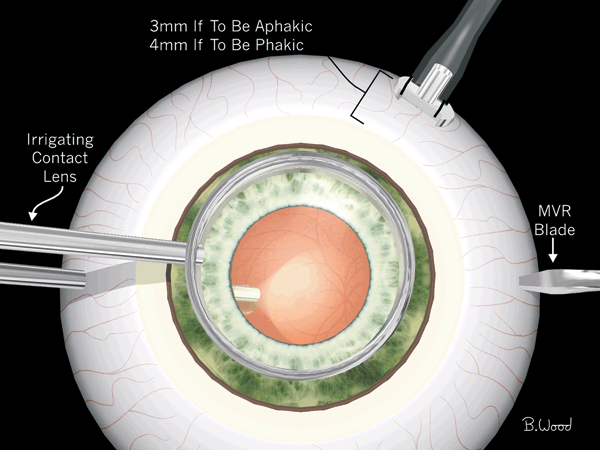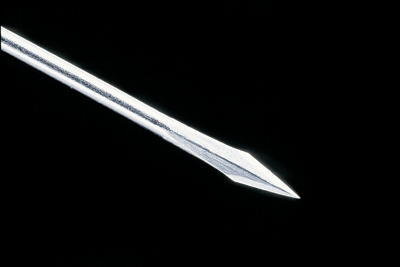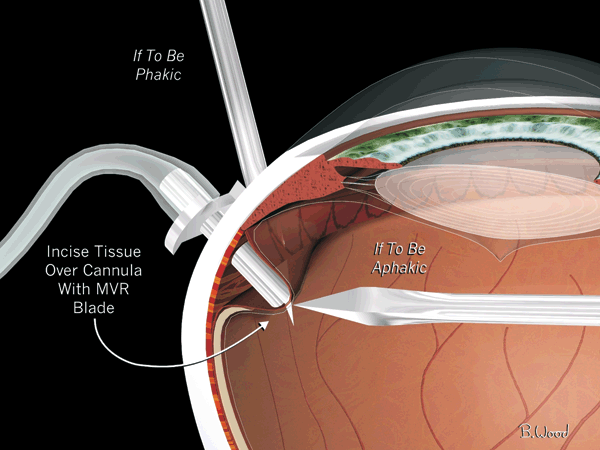Whereas 25-gauge vitrectomy is usually performed transconjunctivally with trocar-cannula systems, 20-gauge vitrectomy usually requires conjunctival incision, exposure of the anterior sclera, and sclera closure and conjunctival reapproximation with sutures. Despite performing nearly all of their vitrectomies with 25-gauge techniques, the authors still find the need for creation of 20-gauge incisions. These may be required, for example, to introduce a 20-gauge fragmenter handpiece to remove pieces of dropped dense nucleus in the vitreous or to introduce diamond-coated 20-gauge forceps to remove intraocular foreign bodies. This chapter will focus on techniques of creation and closure of 20-gauge incisions.
CONJUNCTIVAL INCISIONS
Care should be taken to avoid highly scarred or vascular areas, filtering blebs, setons, and flaps for sutured intraocular lenses (IOLs). Two temporal incisions are made, one superotemporal for the cutter, scissors, forceps, fragmenter, laser, etc. and another inferotemporal for the infusion cannula. They should be limbus-parallel, 1 mm posterior to the limbus, and at the superior and inferior border of the lateral rectus. The superonasal incision is usually for the endoilluminator and should be limbus-parallel, 1 mm posterior to the limbus, and centered at the superior border of the medial rectus. A small radial extension of the limbus-parallel incisions at one end resulting in an L-shaped flap facilitates better exposure and single suture closure.
For any vitreous surgery in which scleral buckling is anticipated, it is best to make a continuous incision 1 mm posterior to the limbus including each quadrant requiring buckling. A limbal peritomy tends to bleed under the contact lens, causes conjunctival retraction and redundancy problems in the postoperative course, and makes postoperative contact lens fitting difficult and dellen more common. Incisions more than 1 mm behind the limbus increase the risk of exposure of scleral sutures and make visualization of the sclerotomies difficult because of the anterior flap.
TRACTION SUTURES
Traction sutures under the muscles are of no value in vitrectomy because the instruments move the eye. Only if scleral buckling is anticipated should traction sutures be used, and then they should be placed beneath the muscles directly, using a short-handled fenestrated muscle hook with chamfered hole. Large sutures (0 to 2-0 silk or cotton) do not cut the muscle tendons and provide a good grip for the assistant. Only the muscles absolutely required for access to the sclera should be trapped to reduce postoperative pain, ptosis, and strabismus. The superior rectus should be avoided if possible to avoid or reduce vertical strabismus as well as ptosis secondary to levator and Mueller’s muscle damage. It is never necessary to remove muscles for scleral buckling or trauma repair in the author’s experience.
20-GAUGE SCLERAL INCISIONS
Sclerotomies for the endosurgical instruments will be focal points for the remainder of the operation (1). If they are incorrectly placed or constructed, the entire course of the operation can be adversely influenced. The incisions should be placed in the anterior pars plana to reduce the risk of damage to the peripheral retina. Contrary to customary teaching, bleeding of the ciliary body is infrequent and rarely serious when it does occur. Except in children, patients with an abnormal pars plana, and microphthalmic patients, the sclerotomies should be placed 3 mm posterior to the limbus if the lens is absent or to be removed and 4 mm posterior if the lens is to be retained (Fig. 10.1). Some surgeons use 3.5 mm for all cases as the authors do for 25-gauge cases. The authors use 25-gauge, sutureless, transconjunctival surgery for almost all cases; the following techniques apply only to sutured 20-gauge surgery.

Figure 10.1  All sclerotomies are made with MVR blade, 3 mm posterior to the limbus if aphakic or lens is to be removed and 4 mm posterior to the limbus if lens is to be retained.
All sclerotomies are made with MVR blade, 3 mm posterior to the limbus if aphakic or lens is to be removed and 4 mm posterior to the limbus if lens is to be retained.
The disposable microvitreoretinal (MVR) blade is ideal for making 20-gauge sclerotomies. The blade is lancet shaped to ensure that the incision is centered at the initial entry point (Fig. 10.2). The blade is 1.4 mm in width, which makes a linear incision that becomes 0.89 mm (20 gauge) in diameter when deformed to a circular shape by the instruments. The nontapered, 20-gauge shank and 25-mm length correspond to the dimensions of the other endosurgical instruments. Stilettos, myringotomy blades, illuminated stab needles, 20-gauge needles, and transilluminators are unnecessary with this method. Prefirming prior to use of the MVR blade is unnecessary because the tip of a high-quality MVR blade is typically as sharp as a 30-gauge needle and provides a correct size incision if a subsequent fluid injection is required.

Figure 10.2  MVR blade has a lancet tip that makes a symmetrical incision around the initial entry point, 1.4 mm blade width to make a 0.89-mm incision for 20-gauge tools; shaft is 20 gauge to make a round opening from the linear incision.
MVR blade has a lancet tip that makes a symmetrical incision around the initial entry point, 1.4 mm blade width to make a 0.89-mm incision for 20-gauge tools; shaft is 20 gauge to make a round opening from the linear incision.
The sharpness of a new MVR blade usually prevents the nonpigmented pars plana epithelium and choroid from being pushed into the eye without penetration. The possibility of penetrating the sclera but not the choroid or pars plana epithelium should be a reminder to use these blades for one case only. To verify proper penetration, the blade should be seen through the operating microscope. Under no circumstances should the naked eye be used to check the cannula nor should the 20-gauge cannula be used for infusion without inspection (although this is commonly done with 25-gauge infusion cannulas). If the eye is soft, a 20-gauge needle should then be placed through the initial MVR incision and infusion fluid injected with the needle tip visible. This step will decrease the chances of suprachoroidal and subretinal infusion. If excessive bleeding through the sclerotomy occurs, it can be treated by external-internal bipolar diathermy using a scleral plug as the internal contact or by placing one blade of the bipolar in the sclerotomy and the other on the scleral surface adjacent to the bleeder.
20-GAUGE INFUSION CANNULA PLACEMENT
Unless there is severe fibrovascular proliferation or some other obstruction discussed above at this region of the pars plana, the infusion cannula is placed near the inferior border of the lateral rectus. In this position, it does not hit the nose, lids, or speculum or interfere with the surgical instruments.
Because it decreases the incidence of choroidal infusion and directs infusion fluid further away from the lens than does the 2-mm cannula, the 4-mm cannula should be used in all cases. Unless it is carelessly directed anteriorly, the 4-mm cannula will not damage the lens. A 6-mm cannula can be used for thick choroid cases but can bump the lens.
The authors make the sclerotomy for the infusion cannula before placing the cannula retention suture. By placing the incision before the suture, each edge of the wound can be grasped with 0.12 forceps and stabilized during suture passage. The tension applied to the sclera makes possible a deep suture bite and wound eversion without opening the deepest part of the incision can be used to judge scleral thickness. The suture bites should be at least three-fourth scleral depth and 1 mm long so that they will not fall off the tabs of the infusion cannula. They should be widely spaced to ensure imbrication of the cannula into the sclera, similar to a buckle. A braided, flexible suture (6-0 silk) is easier to place over the cannula footplates than is a springy nylon or polypropylene suture. Some surgeons use the cannula retention suture for wound closure. The authors are opposed to this method because it compromises imbrication of the cannula into the sclera as well as tight wound closure. Vicryl sutures fray when used for infusion cannula retention and cause significant and long-lasting inflammation (Vicryl scleritis).
After insertion, the cannula should always be inspected with the operating microscope before the infusion is turned on. If the pupil is very small, the indirect ophthalmoscope and condensing lens can be used for visualization. To see the cannula, it is usually necessary to push it gently toward the center of the eye, being careful to avoid the lens, if it is a phakic eye. If the tip appears shiny and clear of overlying tissue, then infusion may be turned on. Observing the cannula with the unaided eye and endoilluminator has insufficient magnification and can result in inadvertent suprachoroidal or subretinal infusion.
If tissue is seen over the cannula, the corrective action depends on the status of the lens (Fig. 10.3). If the eye is aphakic or will be at the end of the operation, the MVR blade is inserted from the opposite side of the eye to incise the tissue over the cannula internally, so that it will retract down over the entire interior portion of the cannula. This technique is also effective if a choroidal infusion is present from previous problems or occurs during surgery from dislocation of the cannula. If the eye is to remain phakic, the cannula should be removed and a 20-gauge needle inserted to repressurize the globe and compress the choroid against the sclera before reinserting the cannula.

Figure 10.3  If tissue is seen over infusion cannula, it should be incised with MVR blade. The blade is inserted from the opposite side of the eye if the eye is aphakic or lens is to be removed and from the same side if the lens is to be retained.
If tissue is seen over infusion cannula, it should be incised with MVR blade. The blade is inserted from the opposite side of the eye if the eye is aphakic or lens is to be removed and from the same side if the lens is to be retained.
Stay updated, free articles. Join our Telegram channel

Full access? Get Clinical Tree


